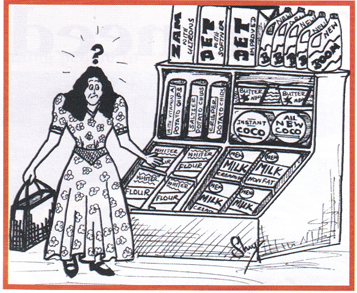The latest crazy disease going around marketers everywhere is the so called “New, Improved” syndrome. Detergent powder ads scream at you: “New, extra strong cleanser!”. Your heart sinks when you see it is that your favourite brand that does this. For you know in your heart, that while it certainly will be different, the odds are that you won’t like it as much and it won’t be as strong as they claim it to be. Consider these:
● The highly competitive toothpaste market has prompted multinational brands to come up with: “Now! All new YYY!” The tube too is new, and made of a plastic material which is lighter. And of course, the price is higher too. The “newness” may be just in the packaging or it can be in the flavour or colour also. They already have red, blue and green.
● Another major area where this syndrome is common, again one of high competition, is the toilet soap market. At every fall in a share point or “gut feeling” of a fall, companies introduce brands that are extensions of the first popular brand. Any number of examples abound. Every time you go to the grocery shop, you see that one or the other brand has changed something.
● The detergent war has also seen many new versions. The latest seems to be the addition of lime to the powder! As if clothes would prefer the smell of lime! Also there seems to be a flood of super-power. super-whitening detergents!
● The syndrome in the edible oil sector is in the form of convenience in packaging, etc. The wine is the same; only the bottle is new.
● You find that this syndrome is becoming quite contagious. It has now attacked the consumer durable marketers. Some marketing whiz kid at a leading refrigerator manufacturer came up with a bright new positioning idea for extra spaciousness. The so-called improvements in the new version are anybody’s guess. To how many of you will it matter whether you can open your fridge from the left or the right?
And what about toilet paper? “Softer” here means they are rolling it more loosely on the spindle, giving you less paper per roll. And they have made it so thin that you can’t even blow your nose on it any more.
How come marketers and manufacturers got infected by this syndrome? Why do they want to change often? And why are most of these changes for the worse? The reasons can be any or all of the following:
1. Technology: The plant where they make your favourite potato chips has become outdated. Some bright researcher in the West has invented a machine that makes them faster and saves money. So, the company makes the big investment only to discover that the plant they bought achieves economy by putting in thinner and smaller potato walers. They decide to solve the problem; now the air-tight, special pack says. “New’ Lighter and Crisper! Untouched by Hand!”
2. Profits: Whatever marketers and marketing gurus may say, forget it. Companies are in business to make money. The market conditions of today can force a company to play with its products in order to stay with the “crowd”. When the availability of a raw material for its product is hit by the new import regulations, the marketer asks the production department either to use less of this raw material in the product recipe or charge more. That seems okay. But what about the times around when the half yearly results are to be published: Increase the profit margins of course. One easy way to justify the new higher price tag to you is to claim that it is an “improved” product. No doubt shareholders while paying more, are happy to see better half-yearly results of their company!
3. Human nature and Corporate Dynamics: Just being competent is not enough anymore. Brand and product man- agers in many of our companies do not get rapid promotions just by being competent. They are expected to do more. It is always, “Mr Vijayaratne, the man behind the extra nutrition put into our Choco Drink, or “Ms Chandrika who added 20% more brighteners into “Det Detergent” not “Mr Vijayaratne ran Choco Drink for three years and everything was fine” or “Ms Chandrika did a good job in the last year’s promotion success of Det”. On the manufacturing side, you bear a different version of this: “Mr D’Souza brought in the ABC blending mixer. Made the coffee granules smaller and finer. Boosted margins by 7% Yes, these are the ways to bend the bureaucracy and get into the fast track-leaving his/her mark behind on the brand. In other words, one has got to change something.
With all these forces conspiring to fix things that are not yet broken, what can be the solution? My suggestion is that manufacturers should take a more active role in reaching out to the customer and seeking his opinion. The advantage to the manufacturer in this is that every time they talk to the man or the woman who buys their products, they get away smarter. So, dear marketers and manufacturers, you will find out that:
● People want to trust labels. Whenever a devoted wife selects Tide or a caring father chooses a Cadbury, it is always the trust they have in these brands that influences the purchase decision. Otherwise, it is not that easy to automatically reach for your brand. However, exceptions to this rule also exist. This trust does not exist in the case of purely hedonistic purchases such as pastries and snacks and also when there is deep discounting.

● Miracles are not expected. The “improvements” customers respond to are usually simple and functional, not cosmetic. Often these would cost less to implement than the cosmetic changes that the manufacturer actually makes. There are exceptions where brand loyalty is concerned. No matter whether the improvement is just superficial (in packaging) or in the core product itself, a devoted consumer automatically reaches out for his brand of toothpaste or whatever.
● People are realistic about pricing. The price sensitivity varies from household to household and from one product category to another. In items carrying small price tags, the prevailing attitude is “we buy what we like and don’t check price tags”. The earlier mentioned potato chips case is a good example in this respect. Here, customers buy what they like. If the company changes its wafer to save money, it may end up losing customers. So, keep up the quality so that most people will pay up, so long as the company does not outpace its field.
So, a word of caution to Marketing General Managers and Managers. Next time when some bright-eyed fresh MBA from USA or UK conclusively proves Brand Y needs changing, tell him or her to go out to the street and find out what the real world has to say about it. That way, “New” and “Improved on your packaging can mean the same thing to you and to your ultimate patrons.




